The Coming Tide: Addressing the Mental Health Needs of New Refugees
As the number of refugees seeking a new home in the U.S. grows, so too does the need for social workers who understand the unique challenges of this population.
Nearly 4.9 million Syrians have fled the country in search of a safe haven since war erupted in 2011. Today, almost one out of four refugees globally is from Syria, joining the ranks of millions from countries such as Afghanistan, Iraq, Kosovo, and Albania, where decades of war and widespread poverty have made living conditions unbearable.
Although many Western countries are providing humanitarian aid to Syrian refugees, resettlement has primarily taken place in the surrounding nations. By the end of 2015, developing regions hosted 86 percent of the global refugee population.
2015 saw a significant shift in migration patterns for refugees, with hundreds of thousands of refugees and migrants landing on European shores. The influx disproportionately affected countries including Greece and Italy, which were unprepared to deal with the unprecedented volume of refugees and migrants. Negotiations within the European Union ultimately resulted in a redistribution of new arrivals, with wealthier countries such as Germany accepting a larger proportion of asylum seekers. However, as more new arrivals flow into Europe every day, many countries will continue to face difficulties providing refuge and resources for this population.
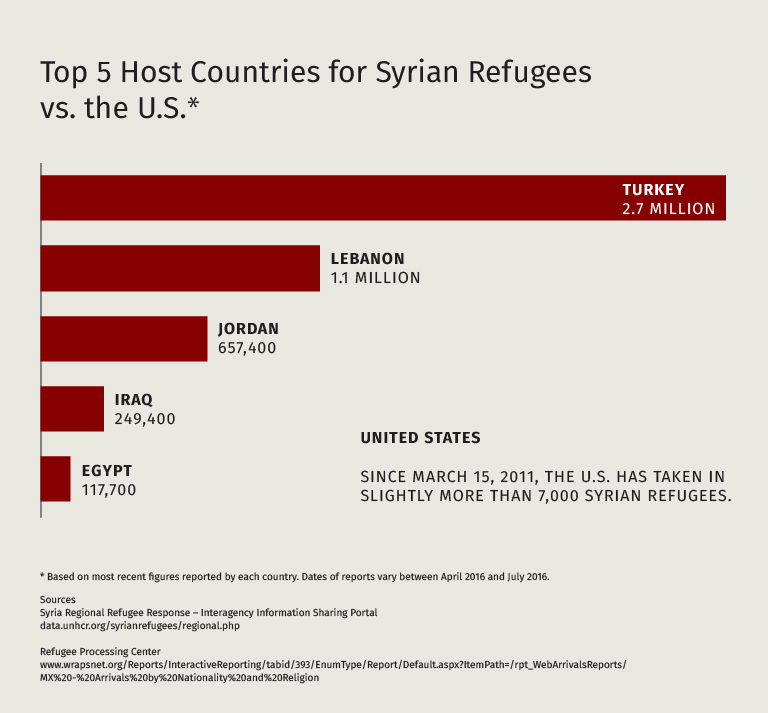
Bar graph showing the top five host countries for Syrian refugees in comparison to the U.S., based on most recent figures reported by each country. Dates of reports vary between April 2016 and July 2016. Turkey hosted 2.7 million Syrian refugees, followed by Lebanon with 1.1 million, Jordan with 657,400, Iraq with 249,400, and Egypt with 117,700. Since March 15, 2011, the U.S. has taken in slightly more than 7,000 Syrian refugees.
Data from Syria Regional Refugee Response – Interagency Information Sharing Portal and Refugee Processing Center.
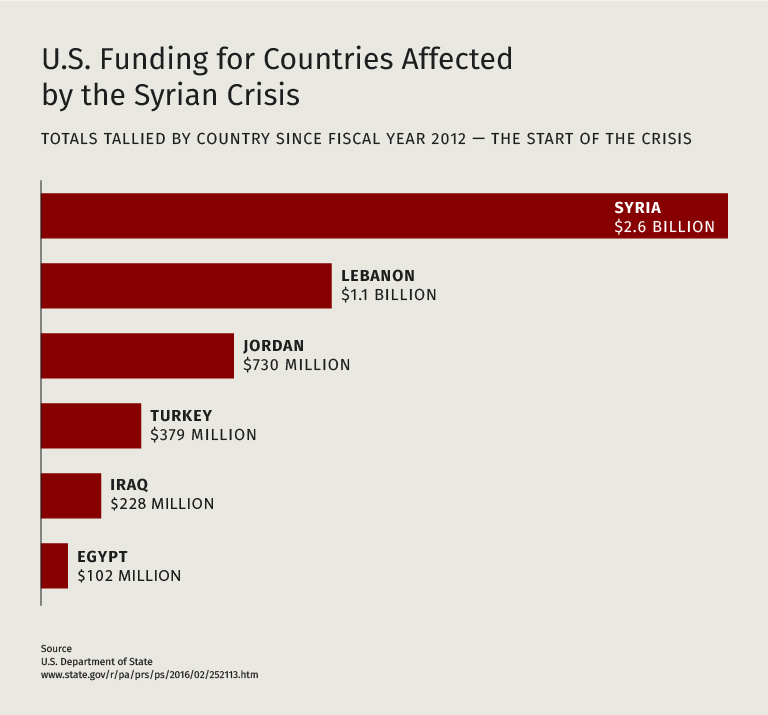
Bar graph showing U.S. funding for countries affected by the Syrian crisis since fiscal year 2012. Syria received $2.6 billion, followed by Lebanon at $1.1 billion, Jordan at $730 million, Turkey at $379 million, Iraq at $228 million, and Egypt at $102 million.
Data from U.S. Department of State.
To address the crisis, the U.S. has committed $5.1 billion in humanitarian aid, the highest amount of any country. In contrast, the U.S. has admitted slightly more than 7,000 Syrian refugees since March 2011, according to data compiled from the Refugee Processing Center. The State Department committed to admitting 10,000 more Syrian refugees between October 2015 and October 2016.
Professor Hugo Kamya, of the Simmons School of Social Work, says geography has largely shielded the U.S. and other North American countries from experiencing the same influx of refugees as Europe. But, he adds, it is only a matter of time before the country is forced to address major global migration movements.
“Europe can only absorb so many refugees. While we are on the other side of an ocean, which makes it more difficult for folks to get here, the U.S. cannot remain isolated and immune from dealing with this issue,” Kamya said. “When opportunities in Europe become limited for refugees, they will look elsewhere and a number will find themselves on the shores of the U.S.”
The Ebb and Flow of Migration
At the end of 2015, the United Nations High Commissioner for Refugees estimated that more than 65.3 million people were displaced worldwide, an increase of almost 6 million people over the previous year. Among those displaced, approximately 21.3 million people were refugees.
The Syrian conflict has dramatically increased the number of refugees worldwide. From late 2011 through 2015, the global refugee population increased by approximately 5.7 million people, or 55 percent, to the highest it has been in 20 years. During that time, Syria replaced Afghanistan as the No. 1 country of origin of refugees, while Turkey overtook Pakistan as the top host country.
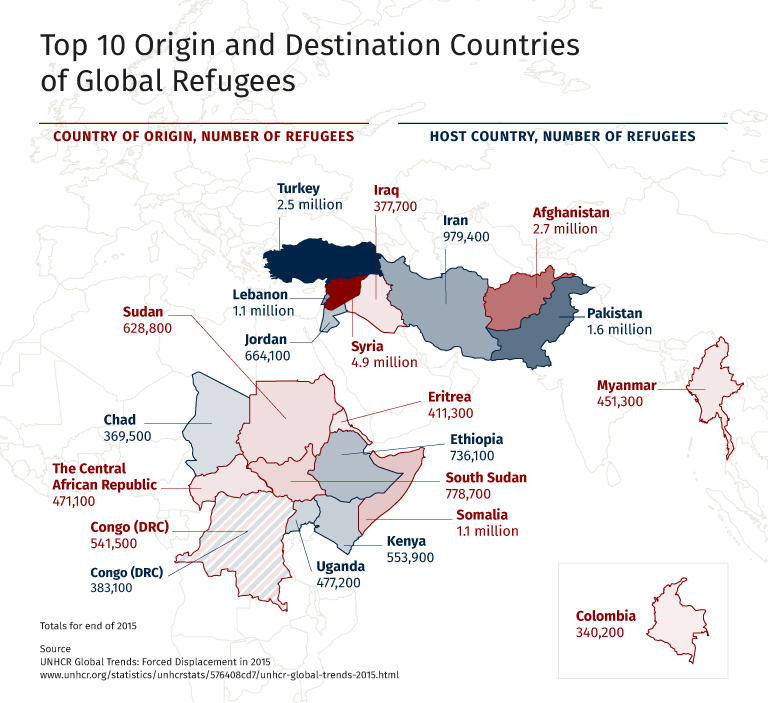
Map showing the top 10 origin and destination countries of global refugees as of mid-2015. Top host countries included Turkey with 2.5 million refugees, Pakistan with 1.6 million, Lebanon with 1.1 million, Iran with 979,400, Ethiopia with 736,100, Jordan with 664,100, Kenya with 553,900, Uganda with 477,200, Congo with 383,100, and Chad with 369,500. Top countries of origin for refugees included Syria with 4.9 million refugees, Afghanistan with 2.7 million, Somalia with 1.1 million, South Sudan with 778,700, Sudan with 628,800, Congo with 541,500, the Central African Republic with 471,100, Myanmar with 451,800, Eritrea with 411,300, and Colombia with 340,200.
Data from United Nations High Commissioner for Refugees – Global Trends – Forced Displacement in 2015.
According to Kamya, Syria’s conflict and the resulting mass exodus reflect larger trends within global migration, particularly as it relates to refugees. Kamya says that a number of push-and-pull factors prompt people to leave their homes.
“The key ingredient to all of this is survival,” Kamya said. “Many of these refugees are coming from places of turmoil, where war, violence, and disaster have left them unable to survive in their homes or countries of origin.”
The civil war in South Sudan, for example, drove the number of refugees from the country up by more than 125,000 people in the first half of 2015. These migration trends are not limited to Africa and the Middle East. In 2014, the U.S. also experienced its own humanitarian crisis at its southern border, when tens of thousands of unaccompanied children arrived seeking refuge from violence in countries throughout Central America.
In addition to violence and war, persecution and discrimination of specific groups based on race, nationality, or religion can also push people out of their home countries.
Migration movements also respond to a number of pull factors.
“The pull factor very often has to do with the search for opportunity. This could be economic opportunities, educational opportunities or survival opportunities,” Kamya said. “Many refugees and migrants are looking for a sense of calm and certainty that a new home promises.”
High unemployment and extreme poverty, coupled with limited educational opportunities, often propel people to leave their home countries in search of opportunities elsewhere. While many of those pulled by the promise of economic opportunity are migrants rather than those seeking safety, these pull factors very much play into the movement patterns of refugees as well. The Migration Policy Institute explains that the influx of new refugees in Europe has been exacerbated by limited opportunities in their first-asylum countries. Essentially, as the war goes on, the surrounding countries, which initially accepted refugees, are unable to continue to provide work and education to this population. These refugees are forced to look elsewhere to rebuild their lives and have turned to Europe.
Invisible Wounds of Refugees
While many humanitarian aid groups tend to focus on providing basic needs such as food, shelter, and clothing, there are number of deeper, secondary issues that often go overlooked. Kamya notes that refugees have “invisible wounds” related to the trauma that they have undergone not only living in their home country, but also leaving their home country. As victims of violence and abuse, they are often plagued by post-traumatic stress disorder and severe anxiety. Many who have been separated from their families or have seen families members killed suffer from survivor guilt. Negotiating their self-understanding of the trauma that they have endured while trying to settle into a foreign place can cause psychological disintegration or breakdown, particularly when nobody is paying attention to mental health concerns.
The receptiveness of host countries also factors into trauma. While some countries receive refugees with open arms, other populations receive refugees with a mix of suspicion and animosity, fearful that they may be an economic drain or a national security threat. For example, the potential admittance of Syrian refugees into the U.S. was met with backlash throughout the nation, stemming from fear that terrorists would use the resettlement process as a channel to enter the country. In late 2015, governors in 30 states requested a halt to resettlement efforts for Syrian refugees, citing concerns over the screening process for Syrians seeking asylum.
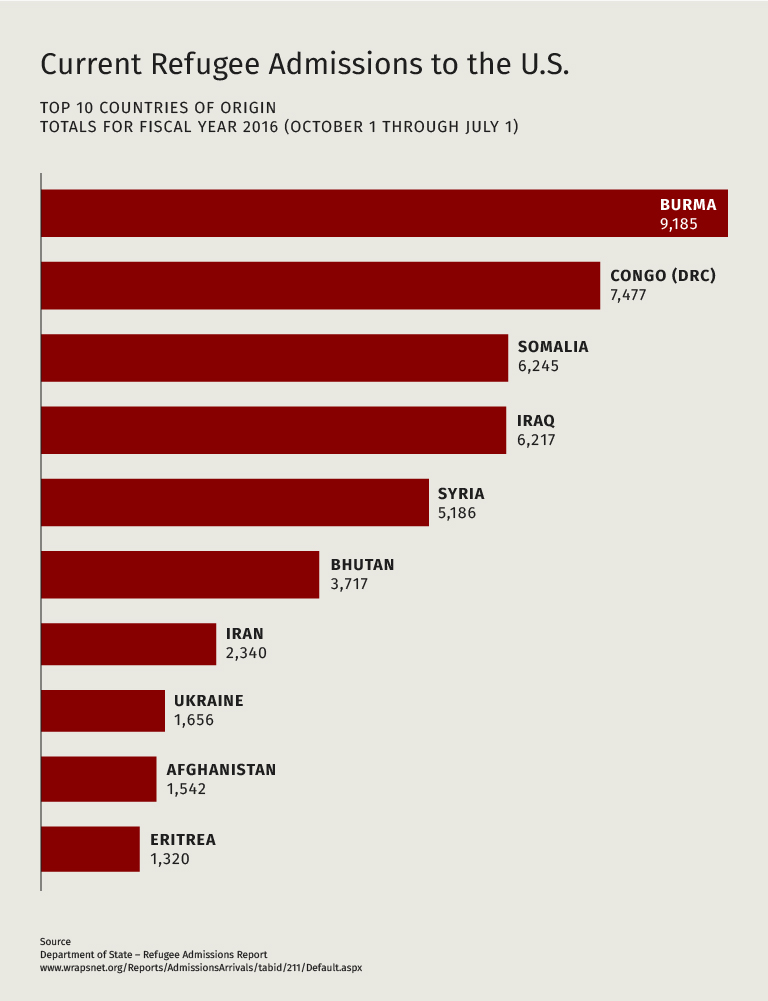
Bar graph showing the top 10 countries of origin of refugees admitted to the U.S. between October 1, 2015, and July 1, 2016. There were 9,185 refugees from Burma, 7,477 from Congo, 6,245 from Somalia, 6,217 from Iraq, 5,186 from Syria, 3,717 from Bhutan, 2,340 from Iran, 1,656 from Ukraine, 1,542 from Afghanistan, and 1,320 from Eritrea.
Data from Department of State – Refugee Admissions Report.
Although the U.S. and other countries continue to take in refugees despite mounting tension, Kamya says discrimination and isolation within host nations can lead to additional problems. For example, many refugees may be vulnerable to exploitation in the workplace, where they are forced to work in poor conditions. They are also at risk of becoming victims of crime and violence.
“As a refugee, there’s a chance that you are going to have to suffer a secondary trauma on top of the traumatic experiences that you have already gone through,” Kamya said. “Experiences of violence and persecution can be doubled or recreated as you enter new host communities.”
Integration, he says, is the key to helping address the mental health needs of many refugees, who also feel suspicious of host populations and consequently disconnected from their new communities. Cultural differences can lead to misinterpretation of interactions as well as feelings of isolation, which create new challenges for refugees. Feeling that they cannot trust people or that they are not loved or cared for can sometimes lead to stress, paranoia, and anxiety, which also result in physical risks that impair everyday functioning. Likewise, many will have difficulty managing interpersonal relationships and carving out a purpose in a new society, due to the fact that they may not know the language or have the right skill sets for new jobs.
Proactive Responses
With the arrival of new refugees on the horizon, social workers and mental health care practitioners must be better prepared to address the unique needs of these populations. Kamya offers the following recommendations for the social work field:
- Schools must provide more opportunities to learn about the new cultural groups arriving and encourage students to engage these groups through teaching, research, and practice.
- The social work field must partner closely with agencies that work directly on resettlement efforts of refugees in the U.S. in order to determine what needs are already being addressed and where social workers can fill in gaps.
- Social workers must begin to pay attention to the needs of specific populations rather than viewing groups of refugees as a monolithic entity. Refugees that come from specific countries within Central America, for example, have different cultural backgrounds despite their proximity to each other and need to be engaged in different ways.
- The field must focus on understanding the unique challenges new refugees experience.
- More research must be done on the entire population of refugees. Most research focuses on the experiences of men; however, the field needs to address differences in gender and develop means of engaging and empowering women.
- The social work field must focus on the vulnerable nature of child refugees. Social workers need to develop methods to minimize the impact of displacement on young refugees and mitigate the effects of transgenerational trauma to ensure that parents and caretakers do not transmit trauma and PTSD to children.
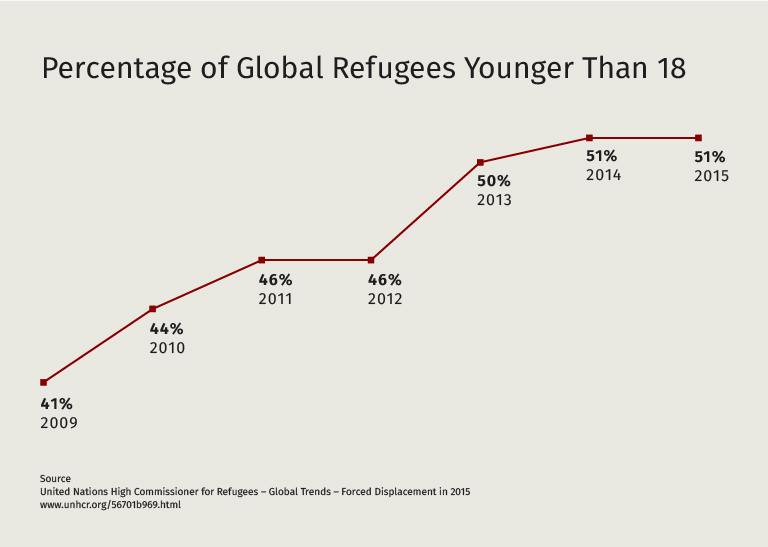
Line graph showing the percentage of global refugees younger than 18 between 2009 and 2015. Refugees younger than 18 accounted for 41 percent of the refugee population in 2009, 44 percent in 2010, 46 percent in 2011, 46 percent in 2012, 50 percent in 2013, 51 percent in 2014, and 51 percent in 2015.
Data from United Nations High Commissioner for Refugees – Global Trends – Forced Displacement in 2015.
Kamya says social workers can play an instrumental part in educating host country residents.
“People need to be informed about who these folks are and where they are coming from. These new arrivals are not simply economic migrants, but people escaping horrible situations and seeking safety,” he said. “This will take a fair amount of willingness for people to put themselves in refugees’ situations, which can be difficult for many in the Western world to grasp.”
Still, Kamya says he believes that populations across the globe will not be able to ignore the suffering of millions.
“The human will and spirit forces people to really think about the need to reach out to the stranger and to help people who have been caught in this turmoil,” he said. “Tension exists, but nations cannot close their eyes to the horrors that refugees have endured, regardless of the political rhetoric all over the world.”
Categories of displaced people as defined by the United Nations High Commissioner for Refugees:
- Refugees: People fleeing violence, armed conflict, or religious or other persecution who should not be returned to their countries of origin due to serious threats to their life or freedom.
- Asylum-seekers: People who say they are refugees, but whose claims have not yet been definitively assessed.
- Internally displaced people: People who fled for reasons such as war or persecution, sometimes perpetrated by their own governments, but legally remain under the protection of that same government, and retain all their rights to protection under human rights and international humanitarian law.
- Stateless people: People who are not considered as nationals by any state under the operation of its law, including people whose nationalities are not established.
- Returnees: People who were of concern to UNHCR when outside their countries of origin, and who remain so for a limited period (usually two years) after returning to their countries of origin.
Source
United Nations High Commissioner for Refugees – Protecting Refugees & the Role of UNHCR


